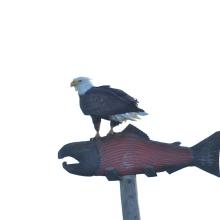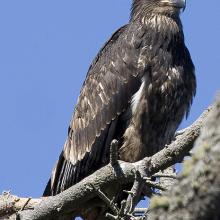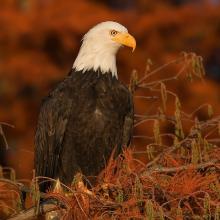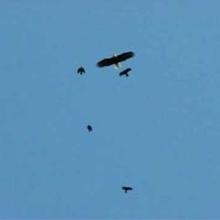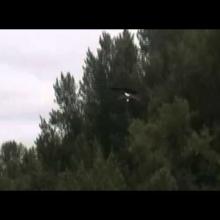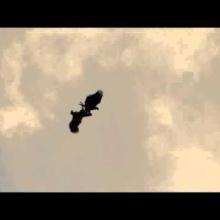

Join BirdNote tomorrow, November 30th!
Illustrator David Sibley and actor H. Jon Benjamin will face off in the bird illustration battle of the century during BirdNote's Year-end Celebration and Auction!
A recently fledged Bald Eagle, a juvenile just learning to fly, lands unceremoniously on the ground. The parent Bald Eagles may react by calling from a tree, or they may have to descend to the ground themselves, to tend to and encourage the young bird to take flight again. Young Bald Eagles do not reach full adult plumage until they are around four years old and may live up to 40 years.
BirdNote®
Baby Bald Eagles
Written by Frances Wood
This is BirdNote!
[Call of a juvenile Bald Eagle]
National symbol though it may be, this juvenile Bald Eagle — not long out of the nest — is anything but graceful at the moment.
[Repeat juvenile Bald Eagle call]
While still in the nest high in a tree, juvenile eagles practice fanning their wings and jumping into the air to test how flying feels. They may even flap out onto nearby branches. When they’re finally ready, the young eagles attempt their first test-flight. Sometimes on these initial jaunts, the birds are likely to lose altitude and land on the ground. [Repeat juvenile Bald Eagle call.]
They’ll rest there for a while, and perhaps get fed by the parents, before they manage to lift off into the air and return to the safety of a tall tree. [Juvenile calling, adult answering]
A juvenile Bald Eagle is the same size as an adult, but differs in coloring. You may have seen one of these birds without realizing it was a young eagle. The juvenile is a mottled chocolate-brown. The young bird keeps this plumage for three or four years, before maturing into the distinctive, dark adult with the contrasting white head and tail.
[Adult Bald Eagle call]
You can see a photograph of a young Bald Eagle — and a video of one fledging — when you come to our web site, BirdNote.org. I’m Mary McCann.
###
Adapted from a script written by Frances Wood
Calls of the Bald Eagles provided by The Macaulay Library of Natural Sounds at the Cornell Lab of Ornithology, Ithaca, New York. Juvenile recorded by G.F. Budney, adult by J. Storm.
Ambient recorded by C. Peterson.
Producer: John Kessler
Executive Producer: Chris Peterson
© 2014 Tune In to Nature.org August 2016 / July 2022 Narrator: Mary McCann
ID#080405BAEAKPLU BAEA-02b




